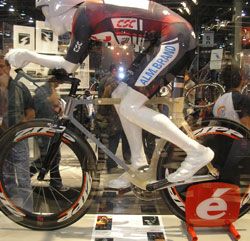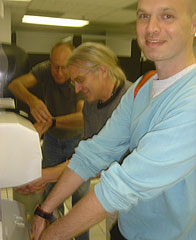Every Interbike tells a story
A theme emerges from every Interbike. If the theme is sufficiently strong, most observers will exhibit a confluence of opinion and we’ll all anoint the theme and hoist a glass to it.
But sometimes I take away something unique to me, probably because I brought an idea or a mood to the show and what I saw confirmed or conformed to it. For me, the hits of the show were the Italians.
As an American manufacturer, which I was (I’m still an American but no longer a manufacturer), I had a chip on my shoulder about the Italians. It was us against them. But now I can afford to not have that chip, and so I saw something at this year’s Interbike that had always been there but I failed to acknowledge it. The Italians have class.

It’s not just their bikes. It’s them. They come to the show dressed to the nines, wearing shoes that cost more than any six pairs of mine. Italians may make expensive bikes, but they pay that same amount for what they wear to the show. How many American triathletes have shoes that cost as much as their race wheels, and suits that cost as much as their bike frames?
They not only bring better clothes to the show, they bring their own food. North American Neanderthals hover around the Italian pavilian hoping to get a pass to the catered room, where the food is better than that served at the Italian restaurants on the Venetian’s Canal Level.
The bikes I can sum up in three words: attention to detail. They may not always grasp all the macro themes that attend tri bike geometry, but nobody gets the details better.
My favorite road bikes at the show were the Kuotas. I know, this is better known as a tri bike company, right? Perhaps, but that’s just because of the success they’ve had in tri, singular among Italian bike makers. But they made the most impressive road bikes at the show too, for my money. And here is a little story about detail orientation. The company head, Mario Comalli, had angst at the presentation of his bikes. They were out of order. “They should be presented in order of ride quality,” he told me, “starting from most comfortable and ending with those models we make with the best power transfer.”
I exhibited at Interbike for 12 years, and I never thought of that.

Notwithstanding my appreciation of the Italians (I’m still a die hard Campy fan though that company barely acknowledges my right to breathe oxygen), there were other good things at the show. My second favorite thing was the bike that only a dummy could ride. It’s being tested at the wind tunnel as I write this, and I’m bummed I can’t attend. It’s a Cervelo P3C with removable and changeable tube shapes. It’s ridden by a Dave Zabriskie mannequin, though I do not know if, like Ken, it’s anatomically correct. I hope so for the sake of aerodynamic precision.
The favorite thing was the Dyson hand dryer in the exhibit hall bathrooms. It’s by Dyson, you know, that guy who invented the new kind of vacuum cleaner? The one that vacuums differently? Well, here’s a hand dryer that actually works! Nevertheless, I had to perform a test before I accepted this truism as fact because, as the engineers say, one test is worth a thousand expert opinions.
Happily, this was easily accomplished, because the Sands Convention Center obliged us by installing the Dyson hand dryer right next to, instead of in place of, the existing hand dryer that never worked worth a spit. So, I manned the stopwatch while Cervelo’s Gerard Vroomen and Steve Hed each tried their “hand” at drying themselves. Gerard’s partner Phil White took the photos for posterity.
I must tell you that Steve Hed dried his hands faster with the old style unit. So he switched places with Gerard and took the reins of the Dyson. Again, Hed’s technique prevailed. I suppose this just goes to show that however you switch the letters around – rider or drier – technique, training and talent trumps technology.
Let's keep that between us, though, shall we?




Start the discussion at forum.slowtwitch.com